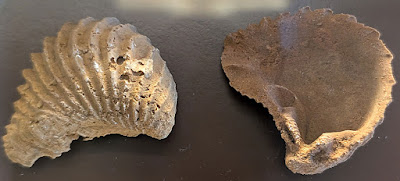Trigonarca matheroniana (d'Orbigny, 1844) is a pelecypod fossil. This genus might be known as Arca (Linnaeus, 1758). It existed during the Cretaceous Period (about 120-70 million years ago ). This fossil was found in Uchaux, France. Fossil was on display at Natural History Museum Vienna (Naturhistorisches Museum Wien) (August 2024).
Monday, June 30, 2025
Trigonarca matheroniana Fossil
Trigonarca matheroniana (d'Orbigny, 1844) is a pelecypod fossil. This genus might be known as Arca (Linnaeus, 1758). It existed during the Cretaceous Period (about 120-70 million years ago ). This fossil was found in Uchaux, France. Fossil was on display at Natural History Museum Vienna (Naturhistorisches Museum Wien) (August 2024).
Labels:
Cretaceous,
france,
Naturhistorisches Museum Wien,
pelecypod
Sunday, June 29, 2025
Pterotrigonia vaelsiensis Fossil
Pterotrigonia vaelsiensis (Boehm, 1884) is a pelecypod fossil. It existed during the Cretaceous Period (about 120-70 million years ago ). This fossil was found in Uchaux, France. Fossil was on display at Natural History Museum Vienna (Naturhistorisches Museum Wien) (August 2024).
Labels:
Cretaceous,
france,
Naturhistorisches Museum Wien,
pelecypod
Saturday, June 28, 2025
Pterotrigonia thoracica Fossil
Pterotrigonia thoracica (Morton 1834) pelecypod is the official state fossil of Tennessee. It existed during the Cretaceous Period (about 70 million years ago - Maastrichtian). This fossil was found in Coon Creek, Tennessee USA. Fossil was on display at Natural History Museum Vienna (Naturhistorisches Museum Wien) (August 2024).
Subscribe to:
Posts (Atom)



